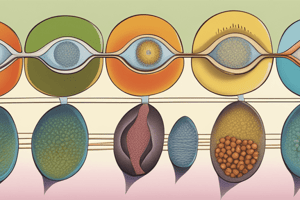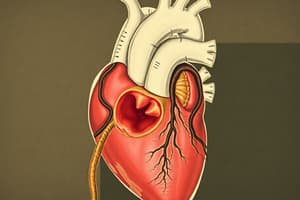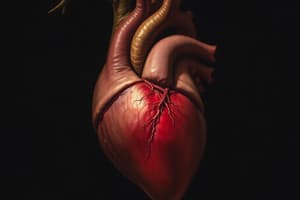Podcast
Questions and Answers
Which structure is involved in the formation of the heart?
Which structure is involved in the formation of the heart?
- Heart tube (correct)
- Pulmonary veins
- Coronary arteries
- Aorta
What is the primary embryonic layer that contributes to the heart's formation?
What is the primary embryonic layer that contributes to the heart's formation?
- Neuroectoderm
- Endoderm
- Ectoderm
- Mesoderm (correct)
Which septum is formed first during heart development?
Which septum is formed first during heart development?
- Interventricular septum
- Atrioventricular septum
- Septum secundum
- Septum primum (correct)
What is the main function of the endocardial cushions in cardiac development?
What is the main function of the endocardial cushions in cardiac development?
Which of the following structures is part of the outflow tract during heart development?
Which of the following structures is part of the outflow tract during heart development?
What is the role of the atrioventricular canals in heart development?
What is the role of the atrioventricular canals in heart development?
During which phase does the heart tube elongate and loop?
During which phase does the heart tube elongate and loop?
Which part of the developing heart is responsible for supplying blood to the body?
Which part of the developing heart is responsible for supplying blood to the body?
What defect is commonly associated with improper formation of the septum primum?
What defect is commonly associated with improper formation of the septum primum?
Which embryonic process involves the fusion of two or more tissue layers?
Which embryonic process involves the fusion of two or more tissue layers?
Which embryonic structure is primarily responsible for the partitioning of the heart into chambers?
Which embryonic structure is primarily responsible for the partitioning of the heart into chambers?
Which structure develops to separate the left ventricle from the aorta?
Which structure develops to separate the left ventricle from the aorta?
What does the term 'pharyngeal arches' refer to in embryonic development?
What does the term 'pharyngeal arches' refer to in embryonic development?
Which embryonic structure gives rise to the structures of the neck and face?
Which embryonic structure gives rise to the structures of the neck and face?
Flashcards
Heart Embryo Development
Heart Embryo Development
The process by which the heart forms during embryonic development.
Primitive Node
Primitive Node
A group of cells in the embryo that signals the development of tissues like the heart.
Endoderm
Endoderm
The innermost layer of cells in an embryo that gives rise to internal organs.
Epiblast
Epiblast
Signup and view all the flashcards
Cardiac Septum
Cardiac Septum
Signup and view all the flashcards
Septum Primum
Septum Primum
Signup and view all the flashcards
Atrioventricular Canals
Atrioventricular Canals
Signup and view all the flashcards
Pulmonary Trunk
Pulmonary Trunk
Signup and view all the flashcards
Aortic Arch
Aortic Arch
Signup and view all the flashcards
Pharyngeal Arches
Pharyngeal Arches
Signup and view all the flashcards
Fetal Circulation
Fetal Circulation
Signup and view all the flashcards
Coronary Arteries
Coronary Arteries
Signup and view all the flashcards
Cardiac Outflow Tracts
Cardiac Outflow Tracts
Signup and view all the flashcards
Endocardial Cushions
Endocardial Cushions
Signup and view all the flashcards
Coarctation of Aorta
Coarctation of Aorta
Signup and view all the flashcards
Study Notes
Embryo Heart Development
- The embryo's heart begins as a simple tube.
- Initially, the heart tube forms from cardiogenic mesoderm.
- The heart tube forms a series of interconnected chambers, including the bulbus cordis, ventricle, and atrium.
- It then fuses to form a more complex structure.
- The heart's position moves from a pre-cardiac location to a more ventral position in the body cavity.
- The heart tube develops a series of folds and bends.
- The folding and bending help to define the distinct chambers.
- The folding and bending also shift the heart tube to the more anterior location.
- Blood vessels develop from hemangioblasts and grow to connect with the heart.
- Endocardial cushions form at AV junctions.
Pericardial Cavity
- The pericardial cavity forms around the developing heart tube.
- It's a potential space that's filled with pericardial fluid.
- The pericardial cavity facilitates heart movement.
Heart Tube Formation
- Endoderm cells lining the heart tube form the endocardium.
- Cardiac myocytes form the myocardium.
- Cardiac jelly fills the space between the endocardium and myocardium.
- The endocardium is the innermost layer of the heart.
- The myocardium is the middle layer of the heart.
- The epicardium is the outermost heart layer.
- The epicardium is an epithelial lining.
Heart Development Summary
- The embryo's heart develops from the cardiogenic mesoderm.
- The heart develops as a simple tube that undergoes folding and bending.
- The heart tube eventually forms distinct chambers.
- Blood vessels connect to the heart.
- The pericardial cavity forms around the heart tube.
Cardiac Septa Formations
- Septa grow to divide the atria and ventricles.
- Septum primum grows from the top towards the endocardial cushions.
- Septum secundum grows from the top towards the endocardial cushions.
- The foramen ovale is a hole between the atria.
Aortic and Pulmonary Trunks
- The truncus arteriosus forms two distinct vessels; the pulmonary artery and the aorta.
- These develop from the truncus arteriosus.
Heart Valves
- AV valves (tricuspid and mitral) form from endocardial cushions.
- Semilunar valves (pulmonary and aortic) form from the bulbus cordis/truncus arteriosus regions.
Coarctation of the Aorta
- Aorta narrowing is a common congenital condition.
- The condition is related to changes in aorta size.
Pharyngeal Arches
- Pharyngeal arches form as a series of outgrowths.
- The pharyngeal arch is made of mesoderm, endoderm, and neural crest.
- The pharyngeal arches develop important structures.
- They are essential for the development of the face and neck.
Important Anatomical Structures of the Heart
- Atria are the entry points for blood from the veins.
- Ventricles pump blood out of the heart to the rest of the body
- All components of the heart must be connected.
Studying That Suits You
Use AI to generate personalized quizzes and flashcards to suit your learning preferences.




